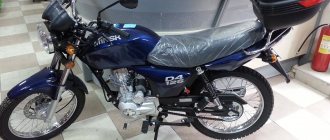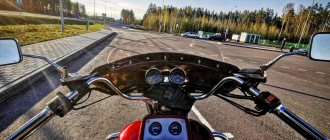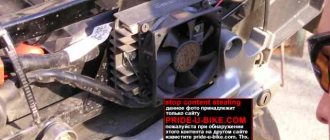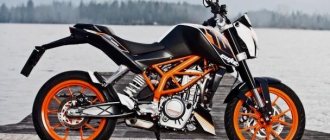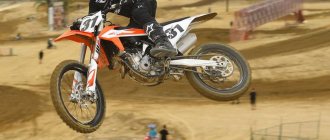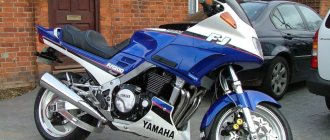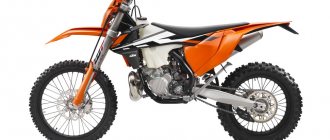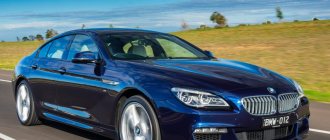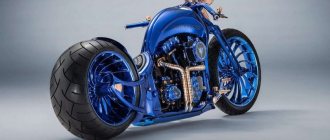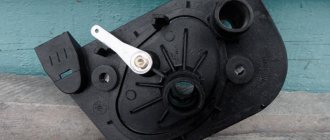The most traumatic part of the car is the bumper, since it is most often scratched, beaten and subjected to mechanical stress. And often, when purchasing a new bumper, you need to paint it to match the color of the car. Painting can be done with your own hands; to do this, you should study the painting technology or watch videos of experienced craftsmen. Typically, this part of the car is made of plastic, which has various properties. Therefore, before you get ready to paint a new bumper, you should study the features of the material itself. This way the part will be painted with high quality and in the shortest possible time.
Preparing the surface for painting
An extremely important point, the level of quality of which will determine the outcome of the work done as a whole. At this stage, it is necessary to carry out high-quality cleaning of the surface of the part being repaired. To do this, use a sponge, warm water and detergent. Oil stains, insect marks and other stains that cannot be easily removed must be cleaned with a solvent or regular white spirit.
Our next step will be sanding the car bumper. Any protrusions and peeling areas must be removed using any sharp object, for example, a regular knife. After you have cleaned the uneven surfaces, you will need to remove the layer of the part using a grinding device.
Bumper sanding
The bumper surface needs treatment on both sides, both inside and outside.
Particular attention should be paid to chipped areas. There is no need yet to try to get the product as smooth as possible; it is enough for the surface to be even
Now it is important to comply with the measure, because in case of excessive effort, the layer can be severely worn off, which can increase the risk of deformation during further use.
Dust that appears during work should be wiped off with a sponge or rag, but the ideal option would still be to use a jet of compressed air. At the end of this step, you need to treat the surface using a hair dryer. Again, you can’t overdo it here either, because you can damage the surface.
Cleaning the bumper from dirt
Contaminants remaining on the part worsen the appearance of the paintwork, so dust and dirt must be removed. The surface is cleaned with any detergent that is dissolved in water.
For this purpose, you can use dishwashing liquid, car shampoo or washing gel. Stubborn stains are removed using more aggressive means, such as White Spirit. The resin must be removed completely, this will help avoid clogging the grinder. Pieces of peeled coating are removed with a sharp object .
Bumper painting for private owners
The lowest prices are available from private craftsmen who paint either at home or in equipped garages, usually on the territory of garage cooperatives. Craftsmen who work for themselves try to quote prices lower than at service stations. Thus, they lure their clientele to themselves. And, I must say, many clients are willing to exchange large stations for a small private box.
However, is it profitable to have your car painted by private painters? Of course, every painter who works for himself tries not only to prove his high level of qualifications, but also to improve his own reputation. Customers understand and appreciate this, which is why they stop using the services of stations with poor service and the same attitude towards people. Many craftsmen working at hired stations, as a rule, have little interest in long-term cooperation with clients.
Prices in private garages and boxes are approximately as follows:
- full bumper painting - $110;
- spot painting - $60-70;
- soldering a bumper - $20-100 (depending on the amount of work).
Private owners can offer free dismantling and installation of some parts, including bumpers, as well as free travel to the scene of the accident for an accurate assessment. The owners try their best to maintain relationships and please customers, while at free stations no one will even give good advice for the future.
Temperature when painting
As already mentioned, it is best to paint the bumper (if it needs to be done outdoors) in warm and calm weather. The lower the ambient temperature, the longer the paint will take to dry. In turn, too long a drying time will have a bad effect on quality.
The optimal ambient temperature for painting is considered to be 20-24°C. It’s okay if it’s a hot summer outside and the temperature rises to 40°C. But painting in the cold is highly not recommended. The minimum temperature is +15°C.
Some manuals allow painting at +5°C, but if you take into account that the bumper will dry outside, then at this temperature the drying time can increase by an order of magnitude.
Interesting video: features of painting a bumper red
- Pitfalls when painting a car bumper black
- How to properly paint a car bumper at home
- Features of painting new plastic bumpers
Useful tips
To make the master happy with the result of the work, you need to follow these tips:
- Paint the bumper only in a warm room without drafts. Otherwise, drying will occur unevenly, and particles of dust and debris will stick to the part.
- If the bumper is new, still do not forget about washing and degreasing it. When particles of fat remain on the surface, the paint does not adhere tightly and peels off.
- Do not dry the painted bumper with a hairdryer. If there is no infrared heater available, then drying should occur naturally.
- If drips or sagging appear, remove them immediately. To do this, you need to sand the defective area well and treat it with polish.
- Make sure that insects do not fly into the room. Mosquitoes and flies can stick to the paint and ruin the whole job. To prevent their appearance, it is worth hanging a net on the door.
- If possible, use materials of the same brand. If the paint, primer, varnish and putty are all made by the same company, they will work better together. The quality of the finished coating will improve, and the risk of mutual rejection of the layers will be reduced to zero.
- Work in the warm season. If it’s winter outside, you’ll have to look for a heated room or wait until it warms up. Otherwise, the paint drying process will be disrupted and the coating will quickly crack.
When painting skills are completely lacking, it is better to try painting on an old car part or on any other surface. After gaining a little experience, you can work on a finishing job - the likelihood of getting an excellent result will seriously increase.
Features of painting and polishing a plastic bumper
The bumper can be painted with completely different paints. However, if it is acrylic, then it can fill in minor flaws from previous materials. But if these are paints from the nitro enamels family (metallic, pearlescent, xerallic), then the bumper must be prepared perfectly, otherwise even the slightest flaw will catch the eye.
Special putty and primer are used when repairing and painting bumpers. Regular materials (for metal) will not adhere to a plastic surface. However, there is a special primer for plastic, after applying which the bumper can be puttied with regular putty. But it is better to do this only in extreme cases.
Often, during painting, dust particles and specks may settle on the surface. They can be removed only when the paint has dried well (no earlier than 24 hours), using sandpaper P-2000 and polish “G-3” and “G-10”. To do this, you need to wipe away the dust particles with sandpaper and polish the part. You can do this by hand, but it is easier to use a polishing machine.
If the bumper is damaged on the right or left edge, then you can paint only half, making a transition in the middle and thereby saving on materials. But if the damage is in the center or there are many of them, then you will have to paint the whole thing. Now you know what it takes to paint a bumper yourself. Put your knowledge into practice!
Interesting video: how to repair a bumper?
- Garage bumper repair or how to solder plastic yourself
- All about the technology of painting a plastic bumper
- Methods for repairing a plastic bumper and painting it
TOOLS AND MATERIALS
You can paint a bumper with the highest quality possible if you have at least an average-quality transfer of paint and varnish materials (paint and varnish materials) with a spray gun, a moisture-oil trap, and a compressor (tips for choosing a compressor for painting). As a moisture separator, you can use a simple catcher installed in front of the spray gun, since the cost of professional separators is very high.
If after painting you want to get a shiny coating that is free of stains, imperfections or many smudges, you will have to spend not only a lot of money on tools and materials, but also time on theoretical preparation. You can learn about the basic aspects of painting in a garage from the article “How to paint a car with high quality with your own hands.” Also, the final result will depend on the chosen painting method.
DETAILS: Toyota Corolla lighting: installation and replacement of lamps || Do-it-yourself replacement of dashboard light bulbs on a Toyota Corolla E110
List of basic materials required for painting the bumper:
- LMB. Pigment varnish (hardener and thinner will also be required) or acrylic enamel or special paint for bumpers;
- Primers. Acrylic primer, hardener (4:1 or 5:1, fillers). To achieve the desired viscosity, an acrylic thinner is also added to the soil. Adhesive primer (primer for plastic that improves adhesion). If the bumper is new and not only the repair area, but the entire bumper is primed, then it is advisable to add an elasticizer to the primer;
- sandpaper gradations P120-P800, scotch-brite gradations 120, 320, 600 (used for matting the surface in hard-to-reach places). If the area of repair and putty is quite large, it is advisable to have a sanding block;
- putty for plastic, spatulas;
- 646 solvent used as a degreaser and lint-free wipes.
METHODS OF PAINTING BUMPERS
- Varnish base. A pigment is sprayed onto the prepared surface, pre-treated with a primer for plastic and primed, which will form the color of the painted part. The pigment is coated with several layers of varnish for durability. The technology is more complex and expensive even when applied to simple colors. An example of a complex color is silver, since the final shade depends not only on the correct selection, but also on the method of application.
- Acrylic enamel. Preparation is similar to the “base for varnish” method. The prepared surface is coated with paint, which is a mixed pigment and hardener, and therefore does not require the application of varnish. Acrylic enamel will not allow the color to fade if the car is painted in a complex shade (silver, metallic, mother-of-pearl).
- Bumper paint. There are special paints for bumpers on sale. Usually you can choose among several colors: gray, dark gray, black, graphite or variations thereof. This type of paint is also called structural paint, since after drying the surface becomes rough and as close as possible to the factory structure of the bumpers. The surface does not require the application of a primer before painting.
- Bumper paint in cans. The material is the same paint for bumpers, but in an aerosol version. Well suited for local repairs, eliminates the need to purchase expensive equipment, but makes it difficult to uniformly apply paintwork to the bumper.
Painting a bumper involves the use of certain materials and tools. Among them:
- Soldering iron for welding cracks.
- White spirit (or other solvent).
- Orbital sander for polishing the surface (or its substitute - an electric drill with appropriate attachments).
- An adapter made of foam rubber is used as an intermediate part between the abrasive wheel and the soleplate of the machine.
- Acrylic primer
- Putty.
- Spray gun.
- Dye.
- Varnish.
- Protective mask.
Bumper spot painting technology
The principle of spot painting is the same for all types of paints. The first task is to cover the primer, which may take several layers, but the main thing is that each layer should be applied a little further than the previous one so as not to create a thick step of paint. When the task is completed, you can accelerate the transition with a special diluent (for example, Mobihel Helios). To do this, you will need a spray bottle with a 0.8-1.2 mm nozzle.
It is important to apply the thinner smoothly and from a distance of 30-40 cm. As a result, the transition will disappear until it disappears (the thinner is applied only to the transition or a little further to remove excess spraying)
It is better not to try to apply the thinner in one layer, as smudges may occur. It is more correct to do 2-3 layers with drying for 20-30 seconds.
Next, all that remains is to rub the transition area (and, possibly, dust particles that fell on other areas during painting) with R 2000-2500 sandpaper and polish the entire part with abrasive pastes. For better results, you can rub it with preservative polish or liquid glass.
The thinner copes with any paint. Whether it is acrylic or varnish, the effect is approximately the same
However, the effect of the solvent must be felt so as not to overdo it, because the thinner greatly dilutes the paint and, if handled carelessly, waves of smudges can instantly appear. Of course, they can be removed by polishing, but it’s better to avoid them
Restoring a damaged bumper
If the bumper has received serious mechanical damage, it must be restored before painting. There are two ways to glue a cracked bumper:
Using a soldering iron
- We drill holes at the ends of the crack;
- We do the initial soldering on the back side of the bumper using a soldering iron;
- We take paper clips and solder them across the crack every 1-2 centimeters;
- Next, solder the crack from the front side.
After you have soldered the bumper, you need to sand it with sandpaper P100, 120. You can use a grinder with a wheel No. 240. Next, to remove dust from the surface, you need to blow the part with compressed air.
Using reinforcing fiberglass
We glue the bumper using reinforcing fiberglass
An easier way to restore a bumper is to use fiberglass. A special repair kit is sold in stores. It includes epoxy resin, hardener and reinforcing fiberglass.
We glue the fiberglass on the outside (it is advisable to glue it in several layers for greater strength). Each subsequent layer is slightly larger than the previous one. 4 layers will be enough. After drying, putty is applied to the back side, the bonding line on the outside is sanded and the entire surface is sanded.
Preparing the bumper for painting
Preparing the bumper for painting yourself is not advisable. It is better to contact a company that does this. The first thing to do is wash it and clean it of resin. To wash the bumper, chemicals and water are used. Then, dried resin particles are removed using a solvent. The next step is to pick out any loose pieces of old bumper coverings.
Grinding. A plastic bumper is prepared for painting with a grinding machine - carefully and carefully cleaned, smoothed out corners, chips, etc. Where the sanding machine does not go through, preparation is done by hand. The skin should be coarse - p120. You should also blow on the surface of the bumper and carefully inspect and feel it. If cracks are found, they need to be sealed on both sides.
Putty. When preparing the surface for painting, all irregularities on the bumper are covered with fiberglass putty. And after the putty has hardened, you should sand it with 120-grit sandpaper. All remaining little things can be tightened with finishing putty. It is treated with soft sandpaper p180. Painting technology involves repeating this procedure in order to obtain a perfectly smooth surface.
Treatment after puttying is carried out for future priming. For example, abrasive p220 covers the entire area of the bumper and removes risks from coarse abrasives and makes the surface matte. Then the bumper is blown with air, degreased and treated with silicone.
Bumper priming. The primer is made with a two-component acrylic primer. Layers of primer are applied to the entire surface of the bumper. We must not forget that soil can flow if it is applied in large quantities at once.
Methods for removing scratches
There are many methods to correct the defect if you scratched the bumper. The most basic of them are aimed at masking damage to the top layer when the paintwork is not touched. These include polishing pastes with different sizes of abrasive, as well as wax products like pencils that fill cracks with a special substance.
Painting is a way to completely damage the production paint layer. When spot painting, it is enough to remove a layer of paint from one area, sand it well and then apply a new layer of a suitable color. If scratches are noticeable over the entire area of the part, the entire bumper must be repaired, with the old paint completely removed.
The deepest scratches without breaks require surface restoration, for which several layers of putty are used. Instructions for using all these methods are provided below.
Wax pencil
For those who have only slightly scratched the bumper, purchasing a wax pencil will be enough. Before using it, you must clean the bumper using special products, and then degrease it with a solvent.
It is best to use a wax marker at moderate temperatures in a warm, windless room. The wax is applied in several layers, and between approaches it is necessary to take breaks so that the layers have time to dry. Apply first with transverse movements, and then with longitudinal ones. It is advisable that the product does not fall outside the damaged area, and if this does happen, then you need to remove the wax using an ordinary napkin. After applying the last layer, the area to be treated should be lightly polished. In addition to filling scratches, such a pencil creates additional protection for the surface - but for this it is better to choose wax of increased hardness.
Coloring
Coloring is, of course, a much more detailed and complex process that requires special tools and materials. Any painting begins with cleaning the bumper, and it does not matter whether you are going to remove it or carry out all the work right on the spot. As in the previous case, the part must be washed, dried and degreased
To polish and remove the old coating, you will need a sanding machine, as well as sandpaper of varying degrees of grit.
- First you need to thoroughly machine the bumper around the entire perimeter; for hard-to-reach places you will need sandpaper, which we use by hand. Then a primer is applied to the surface in two layers, and the bumper is left to dry.
- When the composition has hardened, the bumper is cleaned again and then you can begin painting. In order for the color to adhere well, the part can be slightly heated beforehand.
- The paint is applied using a sprayer or a special gun. It will take about 3 layers, then the surface is varnished.
- For more complex damage, it is advisable to use putty along with the primer.
Filling deep scratches
Using putty requires additional time and manipulation. It is applied after the bumper has been cleaned, degreased and sanded using sandpaper or a machine.
- The putty is applied in a small layer to the scratch so that it fills all the damage. Then you should sand the area. This must be done very carefully so that the surface does not become thin.
- When the first layer becomes smooth and even, you need to repeat the procedure, this time smoothing the surface at a slower speed. Remember to use fine-grit sandpaper for difficult areas, as no power tool can replace hand work.
- After the surface has acquired its previous shape, a primer is applied on top in two layers and all the above-described manipulations with paint and varnish are performed.
- Then it will take at least a day to dry and it will be better if the part dries naturally to prevent it from deforming.
Now you are not afraid of scratching your bumper, since in reality the repair is a fairly simple process that can be done without the intervention of a specialist. The most important thing is to strictly follow the instructions and correctly calculate your skills.
Direct staining
Painting of a plastic bumper is carried out on an exceptionally clean surface. Before painting, you need to wipe the surface again with a cloth to remove dirt and dust, blow with air and degrease. To paint a plastic bumper with your own hands, you can use spray paint.
It doesn't matter whether you use spray paint or regular paint, but apply it in 2-3 layers. Coloring also requires intermediate drying for 10-15 minutes. When painting is finished, you need to apply two layers of varnish with intermediate drying. You do not need to use all the paint from the can, but only the required amount. Painting a new plastic car bumper requires much less effort and cost than an old one. In this case, less spray paint is consumed, polishing is not so complicated, and the whole technology is more accessible to a beginner who decides to paint a car bumper with his own hands, without turning to specialists for help.
Painting the bumper using aerosols
Painting a car bumper for a beginner
Painting the bumper in transition
The technology for working with a car bumper made of plastic, new and old, may differ in complexity, but if you still have questions, you can, for example, watch a video where polishing, painting, and sanding yourself will be shown in detail. Painting a plastic car bumper with your own hands will not be difficult if you use our tips or watch a special video. That's all. The part is like new, and you know all the features of painting a plastic shock absorber.
Antistatic treatment
Most plastics do not conduct electricity well or are insulators at all. As a result, they tend to accumulate a static charge, which attracts dust and small particles of debris. Static electricity is more likely to occur when air humidity is very low. This is especially noticeable in winter, in the presence of “drying” heating. Keeping air humidity above 50% will reduce the likelihood of static charging.
If there is static electricity on the plastic, wiping with a tack cloth may not remove all the debris.
Water helps remove static charge. Therefore, already at the washing stage, static electricity on the plastic is reduced. This is another useful property of washing before painting.
If there are signs of static electricity on the plastic, you can additionally use a homemade antistatic agent: 8 parts distilled water + 2 parts isopropyl alcohol. You can apply the product using a brush (or brush) with soft bristles dipped in this product. Next, you need to wipe the surface with a lint-free cloth and dry it with compressed air. Dust will stop sticking to the bumper.
Primer for plastic that increases adhesion
There is a brutal way to increase the adhesion of plastic to paint by treating the surface with a flame from a torch. This is done very quickly. This causes an oxidative chemical reaction and the paint will adhere better. But since this method is not suitable for everyone, the surface of the plastic is etched with a chemical to create micro-irregularities and “open the pores” of the plastic, to which the paint will stick. These primers should only be applied to bare plastic.
Preparing a new bumper for painting
Preparing a plastic bumper for painting includes the following steps:
- Washing with soapy water. You can additionally use gray scotch-brite. Also, instead of soapy water, you can use some matting pastes (containing detergents). Some painters use Comet for this purpose. The main task of the initial wash is to wash off the release agent (wax, silicone, or soap) located on the surface of the bumper (for separation from the mold during its manufacture). It is necessary that the water stops flowing as if from a wax surface (see photo). It is better to wash the new bumper on both sides. After thorough washing, rinse off any remaining soap with clean water.
- Heating (evaporation). As mentioned above, the plastic bumper contains a small amount of factory release agent, which can penetrate the surface and impair paint adhesion. It is recommended to heat the bumper for 20 minutes with a hairdryer. You need to make sure that the hot air does not melt the plastic. The temperature of the air reaching the bumper should not exceed 80 degrees Celsius. Wax, silicone or other substances (release agent) should come to the surface.
- After the bumper has cooled a little, you need to wash off the released substances with soapy water and Scotch Brite. It is necessary to wash the plastic while it is warm; after complete cooling, the released substances may be partially absorbed into the plastic again.
- After washing, the bumper needs to be dried and treated with antistatic treatment. We will look at this stage in more detail later in this article.
- Degreasing.
- Applying a special primer for plastic that increases adhesion.
Putty - bringing it to perfection
To level plastic parts, use only plastic putty. For severe unevenness and for strengthening, you can resort to putty with fiberglass. For minor cracks, use a medium-grain putty. The best effect is achieved if the putty and hardener are properly diluted.
The proportion is written on the can. Approximately 1:18 . During puttying, you can use both rubber spatulas and metal ones. It is necessary to putty the part until the desired result is achieved.
You can’t putty putty on plastic! It is imperative to matte the surface to be puttied (preferably with a reserve) with R-320 .
The putty can be treated with paint blocks and sandpaper with grit from P-100 to P-400 . The smoother the part, the better the irregularities are felt. After the bumper is removed, you can begin priming.
Repair and painting
High-quality painting of a bumper with your own hands requires 2-3 days (depending on the degree of damage). Often parts are repaired before painting. To complete the preparatory procedure you need:
- Wash the bumper thoroughly, preferably with shampoo;
- Wipe off bitumen stains and resins 646 with solvent;
- Sand the crack with P-150 and then P-240 sandpaper until the plastic is bare (it is convenient to use a sander). In this case, you can clean off the paintwork with a margin of 2-3 centimeters in width from the crack;
- Degrease so that there are no paint residues in the cracks themselves or nearby;
- Connect the plastic and grab it with a soldering iron in several places so as to fix the desired shape;
- Solder the crack on both sides, with a reinforcing mesh (usually the mesh is cut into pieces of 1-2 cm, it all depends on each specific case).
The nuances of grinding
- Some prefer to use a mechanical method in handicraft conditions using a screwdriver or drill with a sandpaper attachment. This is a very crude method that can damage the plastic. It is better to use special chemicals.
- When using a sander, it is better to start with 120 grit. Any remaining scratches can be removed with a stone.
- To correct small cracks, you can use a regular soldering iron. Larger cracks are usually welded with electrodes on both sides.
Precautions when painting a bumper outdoors
You should not expect an excellent result if the bumper is painted outdoors. The risk of defects is very high, since even the cleanest air in nature contains a large number of dust particles. Various flying debris can also land on the bumper.
Undesirable factors when painting:
- wind;
- precipitation;
- dust and debris;
- flying insects;
- pets, children;
- low temperature and high humidity.
You should only decide to paint your bumper on the street as a last resort. It is difficult to find good reasons why it is impossible to find a suitable room for painting such a relatively small element as a bumper. Painting outdoors can be seen as a temporary measure, so there is no point in wasting expensive paint and varnish on it.
If there really is no way to organize a painting room indoors, then you can build a film tent right in the yard. It will cost mere pennies, since all that is needed for such a tent is a few square meters of film and a roll of tape. All this can be bought at your nearest hardware store.
It is best to make a tent with walls. In this case, you will get a full-fledged room with complete isolation from the atmosphere. If there is not enough film, then you can get by with one canopy. But the canopy only saves you if the weather is calm and there are no flying insects.
Sometimes the bumper needs to be touched up without removing it from the car. If it is not possible to do this in the garage, then you can paint it outside and immediately cover the area with clean film. To prevent the film from touching the newly painted bumper, you need to install several supports in advance that can be stuck into the ground.
If the bumper is painted outside, it is better to install it in its natural position (as it is installed on a car). Thus, the likelihood of debris settling is minimized. Even better, half an hour after painting, carefully hang the bumper face down.
Not only insects and debris blown by the wind, but also birds or pets can ruin all the work. If there are dogs or cats on the property, they will definitely show interest in such an unfamiliar and strange-smelling object as a bumper covered with fresh shiny paint. Therefore, you need to take measures - isolate animals from the painting site.
How to paint an old or contract bumper with your own hands
For painting you will need:
- everything is the same as for painting a new bumper
- a grinder or grinder with an attachment for sanding discs
- grinding discs
- sanding blocks of different sizes (70*400 mm rigid, 70*400 mm flexible, 70*200 mm, 70*125 mm, and a small sanding barrel)
- sandpaper of varying hardness for sanding blocks (starting from P120)
- putty
- set of spatulas of different widths
- marker
- brush
- solvent
We dismantle the bumper. We remove all third-party elements (fog lights, radiator grille, fasteners, etc.). We clean the bumper from dirt. We choose a grinding wheel with a hardness of P120, and using a grinder or grinder we begin to evenly remove the old coating. In hard-to-reach places, use a sanding block with appropriate sandpaper.
Quite a rare thing, but if you can find it in a store, buy an aerosol for removing old paint - for example, Body 700. This will make the process of removing old paint easier and save time.
Photo of removing old paint
How it was before using aerosols
Aerosol for removing old paint
The paint swells and peels off the bumper on its own.
When the coating is removed, degrease and find problem areas - depressions that violate the plane of the bumper. It is difficult to find them visually, but if you run the entire plane of your palm across the bumper, you will feel the unevenness. Circle the places you find with a marker so you don't have to look for them again. Let's start puttingty. For each problem area, choose a spatula wider than the unevenness found. Apply the putty not strictly from the beginning of the depression, but a little earlier, and with one confident movement, pull the spatula through the entire dent and onto a flat area. It is better to make a slight bulge out of the dent so that you do not have to wait for the putty to dry and apply a new layer. To prevent the bulge from becoming too large, use a rigid metal spatula and hold it at an angle of 45° in relation to the bumper.
You will have to work quickly with the putty: after adding the hardener, you will only have time to stir the putty, apply and add a couple of adjustments. In order not to waste time, you can mix the putty with the hardener directly on the spatula with which you will apply it. It is convenient to stir it with a second, narrow metal spatula - with its help you will move all the putty to the edge of the spatula for ease of application. Read the can to see what ratio of putty to hardener is required (usually 50:1) and try to stick to it. Don't put too much hardener: the putty will dry faster, but you won't have enough time to apply it properly. Keep a bottle of solvent, a brush and a rag nearby. Immediately after applying the putty, wash the spatula with a brush and wipe it clean. It is very difficult to clean a spatula from dried putty, and if you work with dried pieces, you will not be able to apply new layers evenly.
After the putty has dried, you can begin to level the planes. For this purpose, use the largest possible sanding block and P120 sandpaper. If you choose a block that is too small, or do not use blocks at all, holding the sandpaper in your hands, you may get a new dent, and you will have to repeat the filling procedure again. When restoring planes, try to position the sanding block diagonally so that the edges extend beyond the plane. When the planes are restored, check the entire bumper again: if there are holes left somewhere, do the same with them. Then sand the surfaces with blocks of P180 sandpaper and sand with a soft sander and P240 sandpaper. Blow off dust from the bumper and degrease. You can move on to the next step - priming.
Progress of work in the photo
The first step towards perfection
They removed the old coating, putty the problem areas, and sanded them. Ahead of the coating is primer, paint and varnish
This is what the bumper looks like after the paint and varnish have dried
We reinstall the removed elements: radiator grille, nameplate, license plate
After you have putty all the problem areas, you can use a special finishing aerosol putty to work with small cracks, irregularities and marks from hard sandpaper P120. It is sold in cans, applied in the same way as a primer and helps to achieve maximum smoothness of the product.
Starting with priming, the procedure is the same as with a new bumper. Apply primer, wash, degrease, cover with several layers of paint and varnish, wait for it to dry and enjoy the look of a freshly painted bumper.


